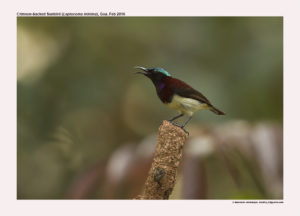Crimson-backed Sunbird

Crimson-backed Sunbird Leptocoma minima
Etymology:
- Leptocoma : Greek word leptos –delicate, fine; kome –
- Minima : Latin word for smallest , least
Vernacular Names:Hindi: Chhota shakarkhora, Guj: Nano shakkarakhoro, Mal: Cheruten kili, Mar: Chotasurya pakshi/ Shinjir
Distribution in India: Resident of Hills of West India.
Description: Size of 8 cm; wt. of male is 4–6 g; wt. of female is 4–5 g. The male breeding has crown iridescent green, side of face are blackish, upperwing and tail are blackish-brown with lilac gloss, back and shoulder are deep red, and rump is metallic purple or lilac. It has a purple throat, crimson upper breast bordered with blackish band below, dull yellow belly, bright lemon pectoral tufts, greyish-white on flanks; iris is dark brown; bill and legs are blackish. The male in non-breeding plumage is similar to female, but brighter olive on head, with back and shoulders as metallic red, rump and uppertail-coverts are metallic purple; lesser upperwing-coverts are metallic red, forming with adjacent part of back as a broad band. The female is olive above, with lower rump and uppertail-coverts as deep maroon-crimson, remiges are edged brown and olive, dull yellow below; iris is dark brown, bill and legs are blackish but paler than male, particularly at base of lower mandible. The juvenile resembles female but greyer, with duller red rump, more yellow below.
Habitat: It is found in evergreen forest, sholas, plantation shade trees, secondary growth and gardens. It is found in 300–2100 m, chiefly in foothills.
Food habits: It eats insects, spiders and nectar. It forages singly, in pairs or in small groups. It is active and acrobatic; clings upside-down to plants, also hovers. It defends flowering trees against conspecifics, also against Flowerpecker.
Breeding habits: They breed in Feb–Mar, May and Dec in west India, Sept–Apr in South India. The nest is a neat, rounded, hanging pouch of fibers, moss and cobwebs, suspended from tip of twig above the ground in bush or sapling, on edge of path or clearing. They lay a clutch of 2 eggs.